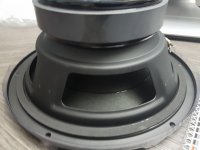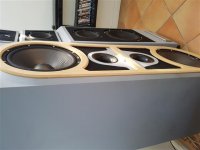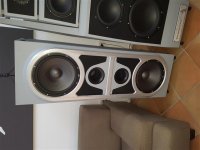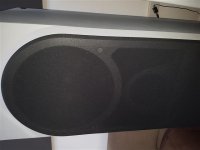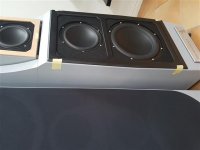Try 50 or 60db range for slightly less scary but still showing good resolution  Also if you haven't seen or tried it the moving mic measurment technique is pretty cool. Moving Mic Measurement
Also if you haven't seen or tried it the moving mic measurment technique is pretty cool. Moving Mic Measurement
It takes a bit of practice to get it right (working out the right speed to do it at is important) and you most definitely need to have non-microphonic microphone cable (found that out the hard way, who'd have thought that microphone cable could be microphonic!)
Tony.
It takes a bit of practice to get it right (working out the right speed to do it at is important) and you most definitely need to have non-microphonic microphone cable (found that out the hard way, who'd have thought that microphone cable could be microphonic!)
Tony.
Ill look into that, Ive just been shooting 6 spots around the LP "Slouch couch" and averaging..Its a Umik, USB.. But I did notice that when I tested using RCA from lappy to Amps, vs HDMI, that there were some differences. not audible , but noticeable with the kit...It was about then I threw my hand up despair ..and realized that I had, more to learn..
Anyone can see that the curve has been attended to. Sometimes what sounds best can be traced to the system directivity. That may take a little planning to measure but I think it would be revealing.
Thanks Al, Im not supposed to be moving 100 + kg mains or heavy furniture..but we do this for love hey,,?
Thankyou Gents..
Some of the issue was attended to by moving them slightly further out of corners, but by far the biggest issue was a x/o error, maybe not an error , maybe you can enlighten me, i bypassed xo and tested the bass drivers separately to compare my measure with the factory,s the, the curves were similar but not the same, I'm guessing because of the in cabinet measure ??. Armed with this info I went back xsim, and a higher SPL at crossover between the 12 and the 8 than was pretty obvious. ATM the 12,s inductors have a bolt jammed in the middle to roll them off earlier, not ideal but it works. The right size bolt and its depth of jamming, by trial and error. . I will rewind these inductors to the measured value of my bolt cored inductors soon.
. I will rewind these inductors to the measured value of my bolt cored inductors soon.  . Thanks for your help during this project..
. Thanks for your help during this project..
Some of the issue was attended to by moving them slightly further out of corners, but by far the biggest issue was a x/o error, maybe not an error , maybe you can enlighten me, i bypassed xo and tested the bass drivers separately to compare my measure with the factory,s the, the curves were similar but not the same, I'm guessing because of the in cabinet measure ??. Armed with this info I went back xsim, and a higher SPL at crossover between the 12 and the 8 than was pretty obvious. ATM the 12,s inductors have a bolt jammed in the middle to roll them off earlier, not ideal but it works. The right size bolt and its depth of jamming, by trial and error.
Last edited:
If in doubt when crossing, don't try to fix the finer bumps and dips. Perhaps take them on an average basis so as to account for the underlying trend. They often warrant further investigation, as the cabinet contributes on different levels.
The bolt idea is ingenious. I agree with adding a few turns later as the bolt may saturate in practice.
The bolt idea is ingenious. I agree with adding a few turns later as the bolt may saturate in practice.
In my quest for knowledge.. The science of sound being the most recent. Prior to that I made mirrors, for telescopes. Working with light has a similarity with working with sound, because they both behave like waves, although light is shitload faster and tolerances are measured in Angstroms. thats one ten-billionth of a meter or 0.1 nanometer. for those that dont know.
One might ask , how the heck do you measure that. That is a topic in itself, and how is it relevant to speakers ?..
One might ask , how the heck do you measure that. That is a topic in itself, and how is it relevant to speakers ?..
Ha ha, yes I did realise that after I submitting that last post, I would have to explain the observed analogy, and it would take several pages of type and only serve as a cure for insomnia for anyone who took the time to read it. So Ill cut straight to the chase explain my understanding and be corrected if I misunderstand, and then pose my question.
The design of these speakers as you see allow for movement back and forth along the z axis, effectively making the baffle infinitely adjustable in terms of slope, or whatever shape. I did say earlier in the thread that even my untrained ears could hear a difference although which one was correct was uncertain. Now with the umik these differences are indeed measurable, and actually quite considerable. It is my understanding that this is caused by phase alignment of the drivers, causing constructive or destructive interference at the range of frequencies where one driver is crossing over to the next, Yes ?. please correct me if I'm wrong..Now the quest for knowledge, I see from other postings that drivers typically are measured from where the voice coil former is joined to the cone/dust-cap, to quantify this mathematically. My question is, Why measure from there. ?...
The design of these speakers as you see allow for movement back and forth along the z axis, effectively making the baffle infinitely adjustable in terms of slope, or whatever shape. I did say earlier in the thread that even my untrained ears could hear a difference although which one was correct was uncertain. Now with the umik these differences are indeed measurable, and actually quite considerable. It is my understanding that this is caused by phase alignment of the drivers, causing constructive or destructive interference at the range of frequencies where one driver is crossing over to the next, Yes ?. please correct me if I'm wrong..Now the quest for knowledge, I see from other postings that drivers typically are measured from where the voice coil former is joined to the cone/dust-cap, to quantify this mathematically. My question is, Why measure from there. ?...
Thats good to know AllenB, I did go and buy a full set of replacement drivers for the speakers yesterday using the excuse that I may not be able to get them if I have a drive failure or damage. Turns out that the subterfuge was unnecessary the WAF is sufficient for me to build another set for the living room anyway..
 . This image is the back of the 8" a little difficult to photograph but maybe you can see why I asked the preceding dumb question with regard to driver depth ,all of the drivers are similar. Whilst I don't really worry about such things, tis more to satisfy my curiosity..
. This image is the back of the 8" a little difficult to photograph but maybe you can see why I asked the preceding dumb question with regard to driver depth ,all of the drivers are similar. Whilst I don't really worry about such things, tis more to satisfy my curiosity..
Attachments
Last edited:
- Home
- Loudspeakers
- Multi-Way
- A 5 way DIY
